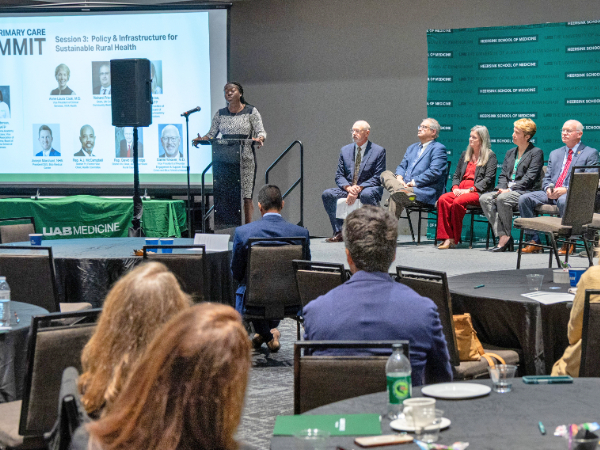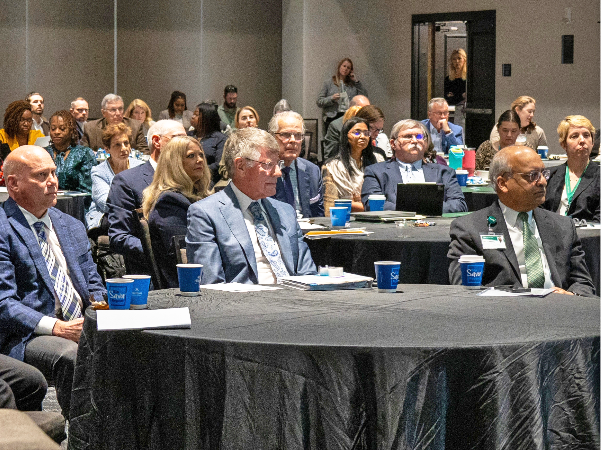 Anupam Agarwal, M.D., dean of UAB's Heersink School of Medicine, gives welcoming remarks. The 2025 Rural Primary Care Summit brought more than 120 physicians, hospital leaders, legislators, and educators together in Birmingham to identify practical, community-driven solutions to sustain rural health care across the state. The event, organized by the UAB Heersink School of Medicine in partnership with the Alabama Academy of Family Physicians (AAFP,) Alabama Area Health Education Centers (AHEC) Network, and Medical Association of the State of Alabama (MASA), focused on strengthening rural health through education, innovation, policy, and partnerships.
Anupam Agarwal, M.D., dean of UAB's Heersink School of Medicine, gives welcoming remarks. The 2025 Rural Primary Care Summit brought more than 120 physicians, hospital leaders, legislators, and educators together in Birmingham to identify practical, community-driven solutions to sustain rural health care across the state. The event, organized by the UAB Heersink School of Medicine in partnership with the Alabama Academy of Family Physicians (AAFP,) Alabama Area Health Education Centers (AHEC) Network, and Medical Association of the State of Alabama (MASA), focused on strengthening rural health through education, innovation, policy, and partnerships.
A call to action for Alabama’s rural health
Alabama ranks No. 45 nationally for health outcomes and faces severe shortages of both primary care and mental health providers. These challenges are compounded by high rates of chronic disease and hospital closures in rural areas.
“When you look at the numbers and rankings, they aren’t just statistics,” said Irfan Asif, M.D., associate dean for Primary Care and Rural Health and chair of the UAB Department of Family and Community Medicine. “They represent our families, neighbors, and communities. It will take all of us working together to ensure every Alabamian has access to high-quality primary care.”
Scott Harris, M.D., MPH, state health officer for the Alabama Department of Public Health (ADPH), opened the summit by outlining the realities facing rural communities: maternity care deserts, transportation barriers, and declining hospital access. He also emphasized how transportation barriers and lack of health literacy contribute to the state’s challenges, and how ADPH can leverage data collection, advocacy, and other tools to combat these issues.
“To keep our state safe and healthy, we must find a way to sustain primary care services and ensure that all Alabamians can access them,” Harris said. “The summit was a great opportunity for bringing together Alabamians who have a deep understanding of the health challenges experienced by our rural communities, and who are committed to finding practical solutions.”
Building the rural workforce
 More than 120 people from across Alabama participated in the summit. The first panel focused on strategies to recruit and retain a robust rural health care workforce. Leaders discussed expanding residency experiences, strengthening pipeline programs, increasing support for community health workers through legal certification and funding, and above all, the need for early recruitment of rural students.
More than 120 people from across Alabama participated in the summit. The first panel focused on strategies to recruit and retain a robust rural health care workforce. Leaders discussed expanding residency experiences, strengthening pipeline programs, increasing support for community health workers through legal certification and funding, and above all, the need for early recruitment of rural students.
“There is a lot of excitement around the Alabama School of Healthcare Sciences in Demopolis,” said Brittney Anderson, M.D., FAAFP, board chair for AAFP and a rural practicing physician. “It’s a tangible example of how we’re investing in the next generation of health care professionals right here in rural Alabama — and that’s the kind of forward-thinking we need more of.”
Panelists also highlighted incentives such as the Alabama Preceptor Tax Incentive Program (APTIP), administered through the Alabama AHEC Network, which last year certified more than $81,000 in credits for physicians, dentists, optometrists, nurse practitioners, certified nurse midwives, certified registered nurse anesthetists, and physician assistants in medically underserved areas who welcome medical, physician assistant, nurse practitioner, nursing, midwife and nurse anesthetist students into their practices for the students’ required clerkships.
Technology and prevention for healthier communities
 Mona Fouad, M.D., MPH, director of the Comprehensive Healthy Living Research Center, speaks on Panel 2. The second panel addressed technology adoption and chronic disease prevention. Participants emphasized using telehealth, broadband expansion, and low-tech approaches such as cell phone outreach to increase access to care.
Mona Fouad, M.D., MPH, director of the Comprehensive Healthy Living Research Center, speaks on Panel 2. The second panel addressed technology adoption and chronic disease prevention. Participants emphasized using telehealth, broadband expansion, and low-tech approaches such as cell phone outreach to increase access to care.
Tapan Mehta, Ph.D., vice chair of research for the Department of Family and Community Medicine, presented on Primary Care HEART-NET — Health Enhancement through Access and Research in Transformative Networks — a multi-state research and innovation network focused on improving chronic disease outcomes in rural populations through digital tools, prevention programs, and partnerships with trusted community leaders.
Henry Ford, co-founder of the Spirit of Luke/A Promise to Help Charitable Foundation, which works to eliminate health care disparities for under-insured populations in the Black Belt region, reminded attendees that technology succeeds only when paired with trust and that churches and clergy can bridge the gap between new technology and community trust.
Policy and infrastructure for sustainable rural health
 Brittney Anderson, M.D., board chair of the Alabama Academy of Family Physicians, moderates Panel 3. The final panel turned to the policies and partnerships needed to stabilize rural hospitals and expand access to care. Discussion centered on innovative payment models, collaboration between large health systems and small facilities, and legislative advocacy to ensure reimbursement and workforce pipelines meet rural needs.
Brittney Anderson, M.D., board chair of the Alabama Academy of Family Physicians, moderates Panel 3. The final panel turned to the policies and partnerships needed to stabilize rural hospitals and expand access to care. Discussion centered on innovative payment models, collaboration between large health systems and small facilities, and legislative advocacy to ensure reimbursement and workforce pipelines meet rural needs.
“Our panel on policy and infrastructure really underscored that there isn’t a one-size-fits-all model for rural health care,” said Anderson, who moderated the panel. “Each community has unique strengths and challenges. My goal was to frame questions that helped uncover what’s working, from partnerships between local hospitals and larger systems to policy shifts that can make or break small practices. I hope attendees left encouraged that sustainability is possible when policy, innovation, and community identity align.”
Looking ahead
 Marnix Heersink, M.D., was among the group of state leaders at the summit. The summit came just weeks before Alabama submits its application for the federal Rural Health Transformation Program, which could bring up to $500 million over five years to support rural initiatives such as telehealth expansion, chronic disease management, and workforce development.
Marnix Heersink, M.D., was among the group of state leaders at the summit. The summit came just weeks before Alabama submits its application for the federal Rural Health Transformation Program, which could bring up to $500 million over five years to support rural initiatives such as telehealth expansion, chronic disease management, and workforce development.
Emily Marsal, executive director of the Alabama State Health Planning and Development Agency, provided an update on the state’s application, which is being developed collaboratively with input from an advisory group of health leaders, legislators, and hospital executives including UAB Health System CEO Dawn Bulgarella, MSHA.
As part of the event, attendees also participated in breakout sessions to identify the most impactful strategies for improving rural health. Their input will inform a forthcoming white paper designed to align stakeholders around actionable, long-term solutions.
“Rural health care doesn’t improve in isolation; it improves when people come together with a shared purpose,” said Anderson. “What stood out to me was how aligned everyone is around sustaining access and strengthening the rural workforce pipeline. There’s a genuine sense of momentum and collaboration that gives me hope for what’s ahead in Alabama.”